|

As far back as 2000 years
before Christ, Hazor was a major city in the Galilee
region. Extra biblical references to the city are found in the
Egyptian Execration Texts and in Akkadian writings from Mari (both
Middle Bronze age), plus later Egyptian texts from the time of
Thutmose III (lived 1504-1450 B.C) and the Amarna Letters (written
between 1400-1335 B.C). Located north of Galilee and south of (the
now drained*) Hula (Huleh) lake, it is quite possible that this city
acted as a regional capital during Canaanite times. Hazor was also
near, and could control, a major trade route from Damascus that
passed south of Hula Lake to Megiddo. (Hula
Lake is 14 miles, 22 km, north of Galilee). During the conquests of
Joshua, Hazor was the source of an organized, yet futile, resistance.
It was perhaps due to this prominence and organizational role that
has the city being treated more harshly that others in the region,
with its complete destruction by fire.
Joshua 10:40-11:13 So
Joshua subdued the whole region, including the hill country, the
Negev, the western foothills and the mountain slopes, together with
all their kings. He left no survivors. He totally destroyed all who
breathed, just as the Lord, the God of Israel, had commanded. 41
Joshua subdued them from Kadesh Barnea to Gaza and from the whole
region of Goshen to Gibeon. 42 All these kings and their lands Joshua
conquered in one campaign, because the Lord, the God of Israel,
fought for Israel. 43 Then Joshua returned with all Israel to the
camp at Gilgal.
11:1 When Jabin king of
Hazor heard of this, he sent word to Jobab king of Madon, to the
kings of Shimron and Acshaph, 2 and to the northern kings who were in
the mountains, in the Arabah south of Kinnereth, in the western
foothills and in Naphoth Dor on the west; 3 to the Canaanites in the
east and west; to the Amorites, Hittites, Perizzites and Jebusites in
the hill country; and to the Hivites below Hermon in the region of
Mizpah. 4 They came out with all their troops and a large number of
horses and chariots - a huge army, as numerous as the sand on the
seashore. 5 All these kings joined forces and made camp together at
the Waters of Merom, to fight against Israel.
6 The Lord said to
Joshua, "Do not be afraid of them, because by this time tomorrow
I will hand all of them over to Israel, slain. You are to hamstring
their horses and burn their chariots." 7 So Joshua and his whole
army came against them suddenly at the Waters of Merom and attacked
them, 8 and the Lord gave them into the hand of Israel. They defeated
them and pursued them all the way to Greater Sidon, to Misrephoth
Maim, and to the Valley of Mizpah on the east, until no survivors
were left. 9 Joshua did to them as the Lord had directed: He
hamstrung their horses and burned their chariots.
10 At that time Joshua
turned back and captured Hazor and put its king to the sword. (Hazor
had been the head of all these kingdoms.) 11 Everyone in it they put
to the sword. They totally destroyed them, not sparing anything that
breathed, and he burned up Hazor itself. 12 Joshua took all these
royal cities and their kings and put them to the sword. He totally
destroyed them, as Moses the servant of the Lord had commanded. 13
Yet Israel did not burn any of the cities built on their mounds -
except Hazor, which Joshua burned. (NIV) [In Joshua 12:19, the list
of kings killed during conquests includes the king of Hazor]
The name Hazor means
enclosed, walled, or fortified. As with many other names have common
place meaning, this increases the probability that there would be
multiple locations in the region sharing the same name. In fact,
during the division of territory in Joshua's time there are two such
references much farther south in the territory of Judah...
Joshua 15:21-25 The
southernmost towns of the tribe of Judah in the Negev toward the
boundary of Edom were: Kabzeel, Eder, Jagur, 22 Kinah, Dimonah,
Adadah, 23 Kedesh, Hazor , Ithnan, 24 Ziph, Telem, Bealoth, 25 Hazor
Hadattah, Kerioth Hezron (that is, Hazor )... (NIV) [See also
Nehemiah 11:31-35]
The northern Hazor, which
is the focus of this article, was located in the north central
territory allocated to Naphtali (later in the Roman district of Galilee)...
Joshua 19:32-39 The sixth
lot came out for Naphtali, clan by clan: 33 Their boundary went from
Heleph and the large tree in Zaanannim, passing Adami Nekeb and
Jabneel to Lakkum and ending at the Jordan. 34 The boundary ran west
through Aznoth Tabor and came out at Hukkok. It touched Zebulun on
the south, Asher on the west and the Jordan on the east. 35 The
fortified cities were Ziddim, Zer, Hammath, Rakkath, Kinnereth, 36
Adamah, Ramah, Hazor , 37 Kedesh, Edrei, En Hazor , 38 Iron, Migdal
El, Horem, Beth Anath and Beth Shemesh. There were nineteen towns and
their villages. 39 These towns and their villages were the
inheritance of the tribe of Naphtali, clan by clan. (NIV)
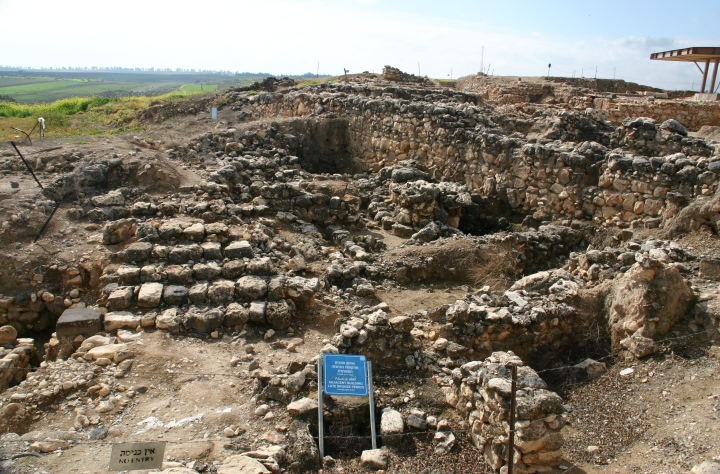
Palace
and adjacent building. Late Bronze Age (time of the Judges, 14-13
century B.C.)
Israel could not maintain
its control over Hazor during the time of the Judges. Hazor was
rebuilt by the Canaanites which set the stage for cruel oppression at
the hands of the Canaanite king Jabin.
Judges 4:1-4 After Ehud
died, the Israelites once again did evil in the eyes of the Lord. 2
So the Lord sold them into the hands of Jabin, a king of Canaan, who
reigned in Hazor. The commander of his army was Sisera, who lived in
Harosheth Haggoyim. 3 Because he had nine hundred iron chariots and
had cruelly oppressed the Israelites for twenty years, they cried to
the Lord for help. (NIV) [Also Judges 4:17, 1 Samuel 12:9]
The remainder of Judges
chapter 4 tells how God enabled the Israelites to defeat Sisera and
ultimately Jabin.
Judges 4:23-24 On that
day God subdued Jabin, the Canaanite king, before the Israelites. 24
And the hand of the Israelites grew stronger and stronger against
Jabin, the Canaanite king, until they destroyed him. (NIV)
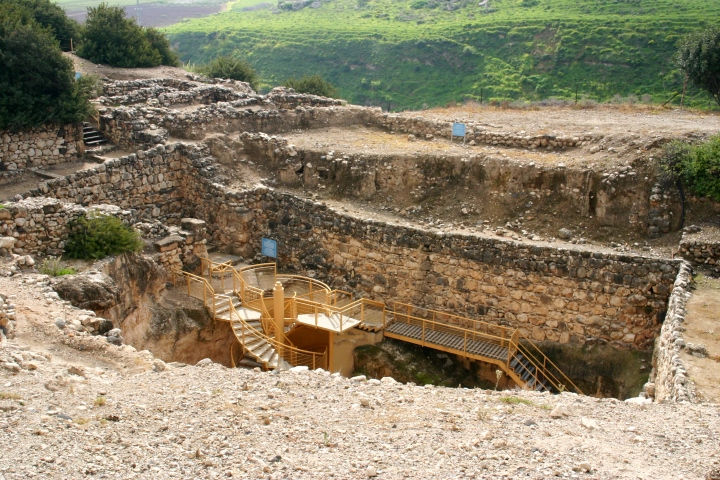
Underground
Water Resevoir (time of the Judges, 14-13 century B.C.)
|
|
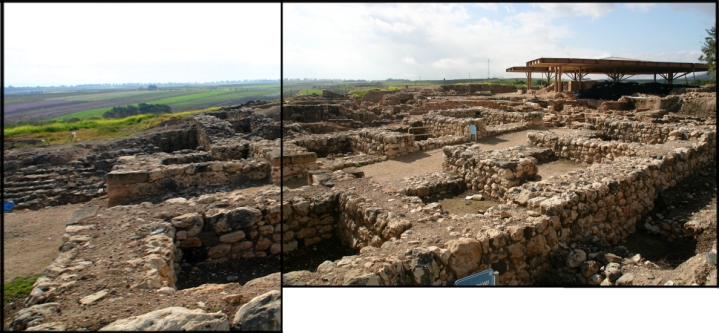
Composite
photo showing massive city gate of Solomon

Diagram
of classic Solomon gate style
Solomon wisely controlled
and fortified Hazor, using its strategic location for military advantage.
1 Kings 9:15-19 Here is
the account of the forced labor King Solomon conscripted to build the
Lord's temple, his own palace, the supporting terraces, the wall of
Jerusalem, and Hazor, Megiddo and Gezer. 16 (Pharaoh king of Egypt
had attacked and captured Gezer. He had set it on fire. He killed its
Canaanite inhabitants and then gave it as a wedding gift to his
daughter, Solomon's wife. 17 And Solomon rebuilt Gezer.) He built up
Lower Beth Horon, 18 Baalath, and Tadmor in the desert, within his
land, 19 as well as all his store cities and the towns for his
chariots and for his horses-whatever he desired to build in
Jerusalem, in Lebanon and throughout all the territory he ruled. (NIV)

Storage
House dating to the 9th century B.C.
Many years later (during
the divided kingdom), circa 743 B.C., when Assyria began to assert
its control over Syria (Damascus), the northern border areas of
Israel were subsequently besieged. Hazor is specifically listed as a
primary target as control of this location would have assured control
of a major trade route to Damascus.
2 Kings 15:29-30 In the
time of Pekah king of Israel, Tiglath-Pileser king of Assyria came
and took Ijon, Abel Beth Maacah, Janoah, Kedesh and Hazor. He took
Gilead and Galilee, including all the land of Naphtali, and deported
the people to Assyria. 30 Then Hoshea son of Elah conspired against
Pekah son of Remaliah. He attacked and assassinated him, and then
succeeded him as king in the twentieth year of Jotham son of Uzziah. (NIV)
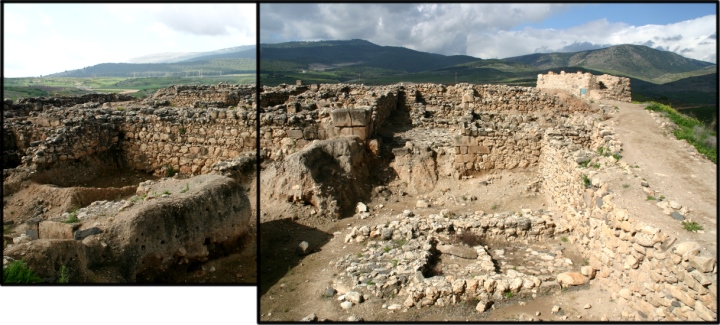
Ruins
of citadel and public buildings dating to 9-8 centuries B.C. (left
and center foreground)
(See
below for tower and wall at right)
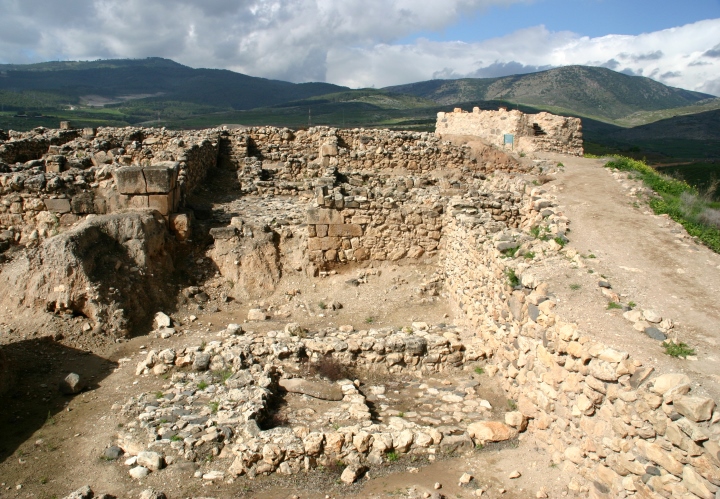
Wall
and watchtower built on eve of invasion by Tiglath-Pileser of
Assyria (mid 8th century B.C.)

Closer
view of the watchtower
Jeremiah prophesied the
destruction and final desolation of Hazor. The massive ruins of today
testify to the fulfillment of this prophecy.
Jeremiah 49:28-33
Concerning Kedar and the kingdoms of Hazor, which Nebuchadnezzar king
of Babylon attacked: This is what the Lord says: "Arise, and
attack Kedarand destroy the people of the East. 29 Their tents and
their flocks will be taken; their shelters will be carried off with
all their goods and camels. Men will shout to them, 'Terror on every
side!' 30 "Flee quickly away! Stay in deep caves, you who live
in Hazor," declares the Lord. "Nebuchadnezzar king of
Babylon has plotted against you; he has devised a plan against you.
31 "Arise and attack a nation at ease, which lives in
confidence," declares the Lord," a nation that has neither
gates nor bars; its people live alone. 32 Their camels will become
plunder, and their large herds will be booty. I will scatter to the
winds those who are in distant places and will bring disaster on them
from every side," declares the Lord. 33 "Hazor will become
a haunt of jackals, a desolate place forever. No one will live there;
no man will dwell in it." (NIV)
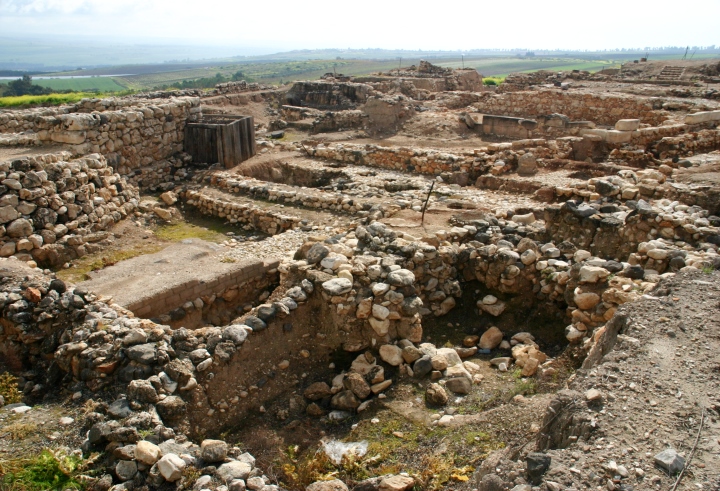
More
of the many ruins at Hazor
(some
show evidence of the mid 8th century earthquake mentioned in Amos 1:1)
|